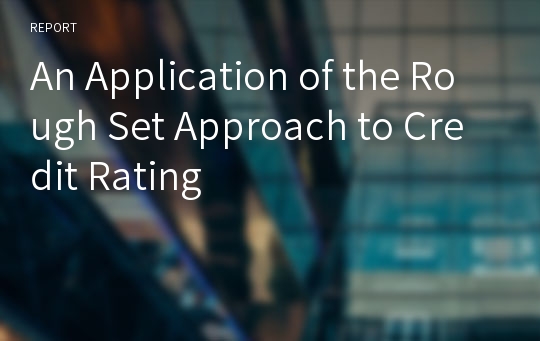An Application of the Rough Set Approach to Credit Rating
블랙죠
다운로드
소개글
러프집합이론(Rough Set Theory)을 이용한 신용도 평가입니다.목차
Abstract1. Introduction
2. Rough Sets and Neural Networks
2.1 Rough Sets
3. A Credit Rating Problem
3.1 Problem Statement
3.2 Application of the Rough Set Approach
3.3 Presentation of Rules
4. Conclusions
References
본문내용
The credit rating represents an assessment of the relative level of risk associated with the timely payments required by the debt obligation. In this paper, we present a new approach to credit rating of customers based on the rough set theory. The concept of a rough set appeared to be an effective tool for the analysis of customer information systems representing knowledge gained by experience. The customer information system describes a set of customers by a set of multi-valued attributes, called condition attributes. The customers are classified into groups of risk subject to an expert’s opinion, called decision attribute. A natural problem of knowledge analysis consists then in discovering relationships, in terms of decision rules, between description of customers by condition attributes and particular decisions. The rough set approach enables one to discover minimal subsets of condition attributes ensuring an acceptable quality of classification of the customers analyzed and to derive decision rules from the customer information system which can be used to support decisions about rating new customers.Using the rough set approach one analyses only facts hidden in data, it does not need any additional information about data and does not correct inconsistencies manifested in data; instead, rules produced are categorized into certain and possible. A real problem of the evaluation of credit rating by a department store is studied using the rough set approach.
참고 자료
[1] Boryczka, M., and Slowinski, R., “Derivation of optimal decision algorithms from decision tables using rough sets,” Bulletin of the Polish Academy of Sciences, ser. Technical Sciences, Vol. 36, 1988, pp.252-260.[2] Dubois, D., and Prade, H., ‘Putting rough sets and fuzzy sets together’, in Slowinski, R. (ed), Intelligent Decision Support: Handbook of Applications and Advances of the Rough Sets Theory, Kluwer Academic, Dordrecht, 1992, pp. 203-232.
[3] Capon, N., (1982). “Credit Scoring Systems: A Critical Analysis,” Journal of Marketing, Vol.46, pp.83-88.
[4] Grzymala-Busse, J.W., ‘LERS – a system for learning from examples based on rough sets’, in Slowinski, R. (ed), Intelligent Decision Support: Handbook of Applications and Advances of the Rough Sets Theory, Kluwer Academic, Dordrecht, 1992, pp.3-18.
[5] Kim, C.Y., Ahn, B.S, Cho, S.S., and Kim, S.H., “The Integrated Methodology of Rough Set Theory and Artificial Neural Network for Business Failure Prediction,” The Journal of MIS Research, Vol. 9, No.4, 1999, (in press).
[6] Krusinska, E., Slowinski, R. and Stefanowski, J. “Discriminant versus rough set approach to vague data analysis”, Applied Stochastic Models and Data Analysis, Vol. 8, 1992, pp.1-17.
[7] Pawlak, Z., “Rough sets,” International Journal of Information and Computer Sciences, Vol. 11, pp. 341-356.
[8] Skowron, A. and Grzymala-Busse, J.W., ‘From the rough set theory to the evidence theory’, in Fedrizzi, M., Kacpryk, J. and Yager, R.R. (eds), Advances in the Dempster-Shafer Theory of Evidence, John Wiley, New York, 1993.
[9] Siegel, P.H., de Korvin, A., & Omer, K., “Detection of irregularities by auditors: a rough set approach,” Indian Journal of Accounting, 1993, pp.44-56.
[10] Slowinski, R., & Stefanowski, J., “‘RoughDAS’ and ‘RoughClass’ software implementations of the rough set approach,” In: R. Slowinski (ed.) Intelligent Decision Support. Handbook of Applications and Advances of the Rough Sets Theory, Kluwer Academic Publishers, Dordrecht, 1992, pp.445-456.
[11] Ziarko, W., Golan, R., & Edwards, D., “An application of DATALOGIC/R knowledge discovery tool to identify strong prediction rules in stock market data,” Proceedings of AAAI Workshop on Knowledge Discovery in Databases, Washington DC. 1993.






















